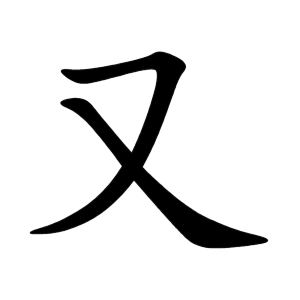又
- again, and, also;
Etymology
Usage in Korean
又 is a typical hand-shaped pictograph and appears as a base component in several radicals related to the hand. For example:
The ⺕ shape used in 聿 and 尹 also derives from the hand shape.
攴 and 殳 depict a hand (又) holding a weapon.
廾 depicts two hands holding something up.
寸 represents the distance from the wrist.
爪 shows fingernails pointing downward.
手 represents the palm facing forward.
In Simplified Chinese, complicated parts are often replaced with 又. Examples include:
對 (duì) simplified to 对,
歡 (huān) simplified to 欢,
權 (quán) simplified to 权
Alternative forms
Characters with 又
3 strokes
4 strokes
9 strokes
又
또
우
tto
u
Kangxi radical:29
Strokes:2
Unicode:U+2F1C
Cangjie input:
- 弓大 (NK)
Composition:
- ⿻ ㇇ ㇏
